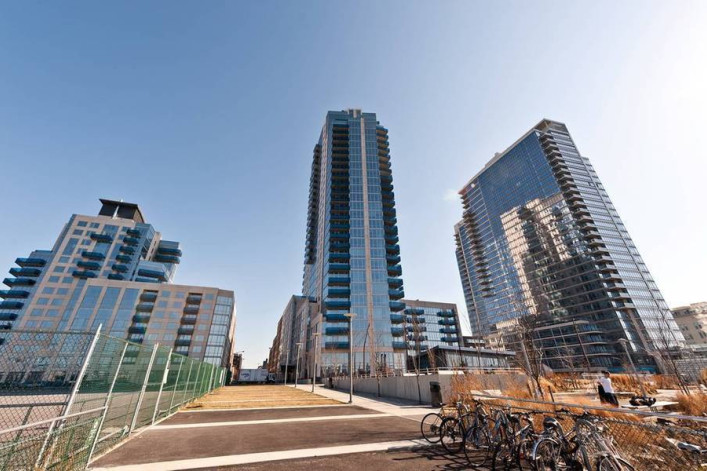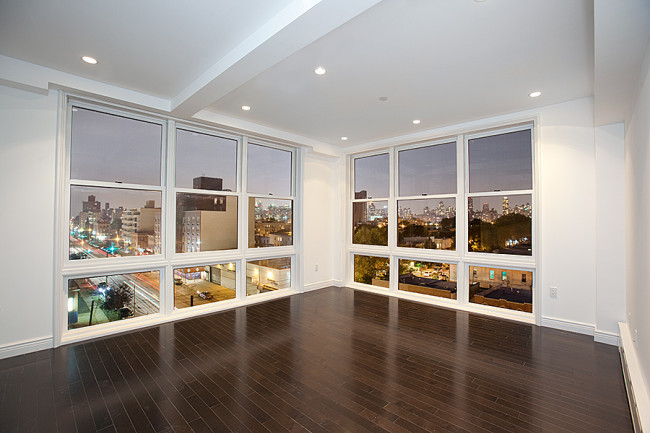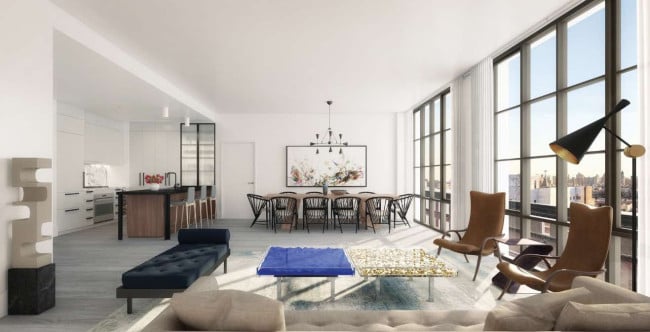Your condo building isn't new anymore. Is it aging gracefully?

The Edge in Williamsburg, built in 2008, was one of the early luxury condo projects for the neighborhood.
Prior to the recession of 2008, a batch of new condo developments came on the market. Some were well built while others were seemingly constructed in a hurry. Now that they’ve had a chance to settle into their bones, it’s a good time in their lifespan to see just how well they were constructed.
Brick Underground asked experts to weigh in on how you could tell if a condo is aging well, whether you are an owner or looking to purchase in a building that is a decade or a little older. There are two main areas to consider. “There’s the physical plant and how it’s holding up, and then there is how it is standing the test of time aesthetically,” says Steve Kliegerman, president of Halstead Property Development Marketing. Here's what to look out for.
Check out the condition of the lobby and amenity spaces
This may seem obvious, but the first thing to do is take a look at the lobby and the amenities. Were they designed to be (relatively) timeless in style, or does it look like they were based on what was popular in 2006?
“I represent a lot of buildings that fall into that age category, and it’s interesting because around the 10-year mark is when the lobby looks a little tired or the amenity spaces need sprucing up. All of a sudden the building goes from being a new building to not being such a new building,” says co-op and condo attorney Robert Braverman, of Braverman Greenspun.
Braverman cites an example of a 10-year-old building that had a private spa, but only a few people used it.
“Now the board is thinking of spending a lot of money to repurpose that space and there may be an assessment for that,” he says.
Also, look at the finishes in the lobby and elsewhere. That’s not to say there won’t be some signs of aging after a decade, but If they were high quality and well constructed, they will hold together pretty well.
“Lower quality details will deteriorate quicker, and you’ll be able to see more wear and tear,” says Stephen Glascock, president of real estate investment and development company Anbau.
Review the exterior envelope of the building
This means everything from the roof to the façade to the windows. Find out whether the roof has been replaced already, or if it needed repairs, or find out where you are with its warranty, which can last anywhere from 10 to 20 years.
It's especially important to look for ongoing water problems or leaks in the building.
“Water will kill you every time,” says Ben Igoe, owner of JBS Project Management, a development management company. “This is always a challenge, not just for the roof, but also the façade. Look for cracks or mortar that’s been replaced.”
You should also look in the basement to see if there are water stains on the floor or walls, water along the sills or trims, or if there’s a damp or musty smell, he adds.
Local Law 11, now called the “Façade Inspection Safety Program,” is for buildings six stories above grade or taller. The city requires a façade check every five years and it has to be reviewed by a New York Sate-licensed architect or engineer. Look up past reports and see when your building is due for its next checkup.
“After 10 years, in a new construction building, you wouldn’t expect there to be too many repairs to the façade. If there are major repairs after 10 years, that may be a sign of a relatively poor construction,” Kliegerman says.
Check the windows
Igoe advises checking to see if the windows are still waterproof. Sometimes the caulking fails.
There’s been rapid improvement on window systems in the past 10-15 years, he notes. Check if the building used the best available technology at the time it was constructed—are the windows thermal pane, triple glazed, ordouble glazed? If an aluminum frame, the cold will get in.
Glascock recommends you rattle the handles of the windows. “They should be solid and feel solid. If they are heavy, they should feel substantial, but shouldn’t be difficult to open, and they should close solidly.”
Sound is another issue. How well insulated are the windows and do they keep street noise out?
Consider the floor layout
A good layout makes a big difference, Glascock says. If there’s a space or closet that is undersized or can’t be used, “that’s a sign the project wasn’t very well conceived.” A good developer will have architects optimize the plans to make sure there’s not a lot of wasted space and owners can easily get from one part of the apartment to the other.
Review the mechanicals
As with the roof, review the guarantee and maintenance records for the elevator and the HVAC systems, and the physical plant. Find out how many repairs have already been done.
Did the developer use central air? “It’s the way of the future,” Glascock says. “It’s more energy efficient and pleasant, and you don’t have to talk over window or PTAC units.”
Request documents and query the managing agent
Start with the condo board meeting minutes or the property manager’s report, if you’re looking to purchase in a 10-plus-year-old building. “Those things would indicate whether the building is holding up and if the board is talking about any major capital improvements, be they physical, structural, or mechanical,” Kliegerman says.
You can also request a copy of the offering plan. Usually this is for people purchasing in a building that’s not yet completed, but you can review it to determine the building's structure, what finishes were planned for the kitchen and bathrooms, and if any need to be updated, where they should be replaced with ones that are the same quality or better. “That [document] can provide a lot of information,” Glascock says.
Consider submitting questions to the managing agent, or ask the seller, or the seller’s broker.
Look at the relationship of the developer to the building
See if there are any ongoing disputes or litigation with the sponsor. “Just because a building has been operating for 10 years doesn’t mean the board and sponsor may be done with each other,” Braverman says. Are there ongoing construction-related disputes? Did the sponsor get the certificate of occupancy? Some buildings may have been open a decade a still not have a CO.
“If you live in the building, you should be aware of this,” he adds.
You Might Also Like

























